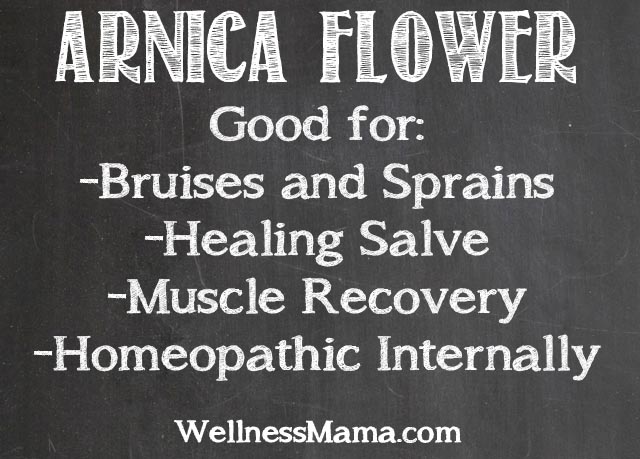I use many herbs daily for their medicinal, culinary and therapeutic properties. One herb that I don’t use daily but always keep on hand is Arnica (or scientifically, Arnica Montana).
Though this is not an herb that can be taken internally, it has definitely earned its place in our house. It is well known for its ability to help externallywith bruises, sprains, strains, etc. and can remove shock and speed healing. It can be put on areas of trauma after falls, accidents, etc.
Arnica is native to Europe and has been used for centuries. Many athletes use some form of it to recover from muscle strain and speed recovery after a work-out.
Though it should never be taken internally, some homeopathic remedies are available that are generally considered safe. It should also not be applied to broken or burned skin.
From Mountain Rose Herbs:
How to Use:
It can be used in various ways depending on the need:
- On the skin as an infusion to spray on for aches and sprains (1 teaspoon dried herbs in 1/2 cup water)
- A tincture (1 ounce dried flower preserved in 8 ounces/1 cup of food grade alcohol)
- An infused oil (1 ounce dried flowers preserved in 4 ounces/.5 cup oil) This post explains how to make an infused oil.
- Arnica oils and creams are used topically to treat sprains, bruises, and muscle pain. Diluted tinctures of arnica are used in foot baths (1 teaspoon of tincture to a pan of warm water) to soothe sore feet.
- Homeopathic arnica is traditionally used to treat seasickness. Research published in June 2005 in the journal Complementary Therapies in Medicine found that homeopathic arnica can reduce post-partum bleeding.
Important Notes:
Arnica is never to be used internally and it is important not to ingest any form of arnica except homeopathics. It is also not recommended to apply to broken or cut skin and some people may notice skin irritation from the use of arnica topically. Not recommended (even topically) while pregnant or nursing. (except in homeopathic form)
Arnica Salve Recipe
Arnica can be used in tinctures, salves, vinegar tinctures, decoctions, etc. Here is a recipe for a salve I always keep in the house:
- 3/4 cup oil infused with arnica (see this post for details on how to infuse oils) You can also buy the oil pre-made oil to save time.
- 1.5 oz Beeswax
- A few drops of Wintergreen Essential Oil (also not for use during pregnancy- consult with a certified aromatherapist to make sure you are using this or any essential oils safely)
Directions: Warm oil in double boiler. Add beeswax and stir until melted. Add Wintergreen Oil in desired amount (warning-wintergreen is very strong!). Pour into desired storage container (we use small tins or little jam jars). Let cool.
Can be used on bruises, sprains, strains, head bumps, etc.
Other Natural Remedies:
Check out my full index of natural remedies by clicking here.
If you’re just getting started with natural remedies, I’d also recommend some of these basic recipes:
- How to make a glycerite tincture
- Lavender and Honey burn salve
- Herbal Electuaries
- DIY Herbal Liniment Recipe
- Fire Cider Cold and Flu Buster
- How to make an herbal poultice with herbs
- Herbal Hand Sanitizer Recipe
- Natural remedies for allergies
- Homemade cough syrup
- Make your own natural remedies kit for your home
- Healing Salve Recipe
- Make your own vapor rub
Ever used Arnica? How did it work for you? Share below!




Leave a Reply